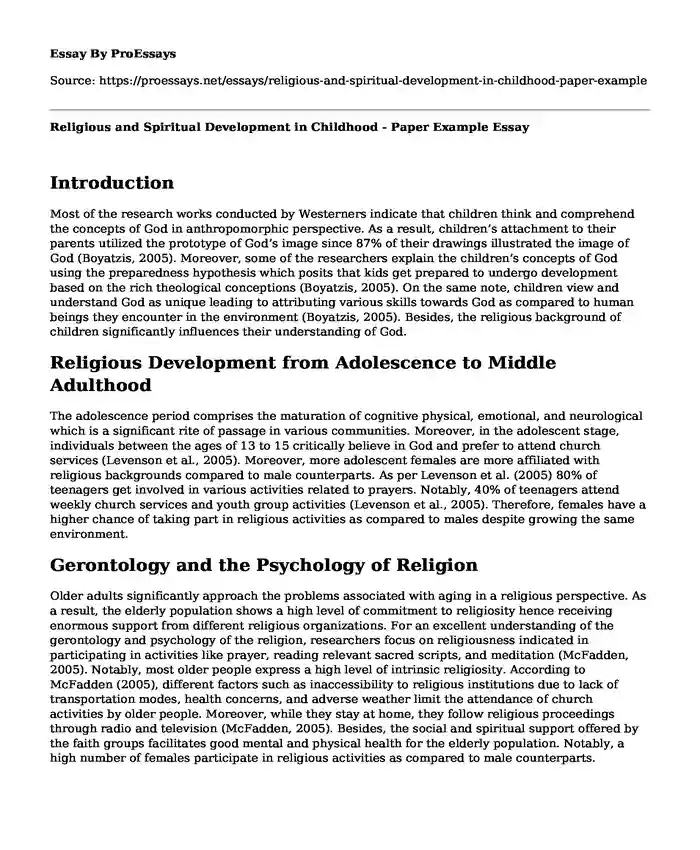Introduction
Most of the research works conducted by Westerners indicate that children think and comprehend the concepts of God in anthropomorphic perspective. As a result, children’s attachment to their parents utilized the prototype of God’s image since 87% of their drawings illustrated the image of God (Boyatzis, 2005). Moreover, some of the researchers explain the children’s concepts of God using the preparedness hypothesis which posits that kids get prepared to undergo development based on the rich theological conceptions (Boyatzis, 2005). On the same note, children view and understand God as unique leading to attributing various skills towards God as compared to human beings they encounter in the environment (Boyatzis, 2005). Besides, the religious background of children significantly influences their understanding of God.
Religious Development from Adolescence to Middle Adulthood
The adolescence period comprises the maturation of cognitive physical, emotional, and neurological which is a significant rite of passage in various communities. Moreover, in the adolescent stage, individuals between the ages of 13 to 15 critically believe in God and prefer to attend church services (Levenson et al., 2005). Moreover, more adolescent females are more affiliated with religious backgrounds compared to male counterparts. As per Levenson et al. (2005) 80% of teenagers get involved in various activities related to prayers. Notably, 40% of teenagers attend weekly church services and youth group activities (Levenson et al., 2005). Therefore, females have a higher chance of taking part in religious activities as compared to males despite growing the same environment.
Gerontology and the Psychology of Religion
Older adults significantly approach the problems associated with aging in a religious perspective. As a result, the elderly population shows a high level of commitment to religiosity hence receiving enormous support from different religious organizations. For an excellent understanding of the gerontology and psychology of the religion, researchers focus on religiousness indicated in participating in activities like prayer, reading relevant sacred scripts, and meditation (McFadden, 2005). Notably, most older people express a high level of intrinsic religiosity. According to McFadden (2005), different factors such as inaccessibility to religious institutions due to lack of transportation modes, health concerns, and adverse weather limit the attendance of church activities by older people. Moreover, while they stay at home, they follow religious proceedings through radio and television (McFadden, 2005). Besides, the social and spiritual support offered by the faith groups facilitates good mental and physical health for the elderly population. Notably, a high number of females participate in religious activities as compared to male counterparts.
Subtopic: Identity
Identity occurs as the process of defining one’s self based on unique characteristics such as aspirations, attitudes, roles, and beliefs. Notably, individuals can achieve identity in different ways for instance, religious identity originates from parental beliefs (Levenson et al., 2005). Similarly, factors such as ethnicity, gender, and vocational act as sources of people’s identity (Levenson et al., 2005). On the same note, parents have a significant influence on the children’s religious behaviors in which they grow to understand their religious identity.
Subtopic: Stages of Religious Cognition
Religious cognition has various theories such as universal sequential stages in which it possesses various stages. Levenson et al. (2005) explain that phases include intuitive projective, mythic literal, synthetics conventional, individuative reflective, conjunctive faith, and universalizing religion. Moreover, during these stages, individuals affiliated with different faiths experience dilemmas in perspectives of faith versus fear, sacred versus profane, eternal versus external life material, and hope versus despair to name a few (Levenson et al., 2005). Notably, such dilemmas have diverse solutions to ensure that people align with faith requirements such as religious heteronomy and possessing the capability of impacting the divine. Furthermore, the reintroduction of the divine at a personal level by accepting religious relativism facilitates the solving of various dilemmas in multiple stages of religious cognition.
References
Boyatzis, C. J. (2005). Religious and spiritual development in childhood. Handbook of the psychology of religion and spirituality, 123-143.
McFadden, S. (2005). Gerontology and the Psychology of Religion.
Levenson, M. R., Aldwin, C. M., & D’Mello, M. (2005). Religious development from adolescence to middle adulthood. Handbook of the psychology of religion and spirituality, 144-161.
Cite this page
Religious and Spiritual Development in Childhood - Paper Example. (2023, Dec 13). Retrieved from https://proessays.net/essays/religious-and-spiritual-development-in-childhood-paper-example
If you are the original author of this essay and no longer wish to have it published on the ProEssays website, please click below to request its removal:
- Articles Review on the Importance of Work Experience
- Experience in Saint Demetrios Greek Orthodox Church Essay
- The Situational Analysis and the Strategic Communications Plan Paper Example
- Research Paper on Paternity Fraud: Millions at Risk of Supporting Non-Biological Kids
- Essay Sample on Mysticism and Isaac Luria: Exploring Spiritual Life
- Love Is Not Enough: Understanding the Complexities of Relationships - Essay Sample
- Research Paper Sample on Servicemen and Their Families: Challenges and Trauma







